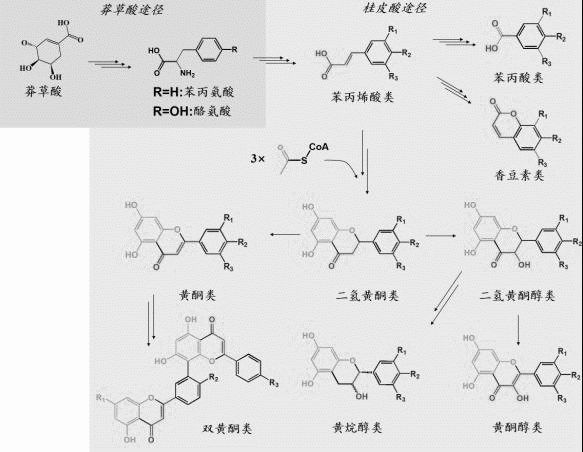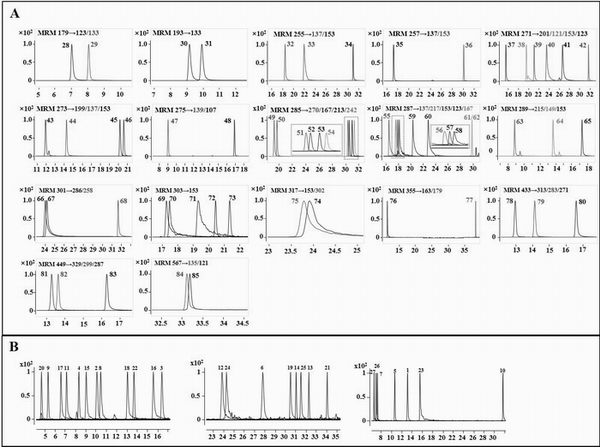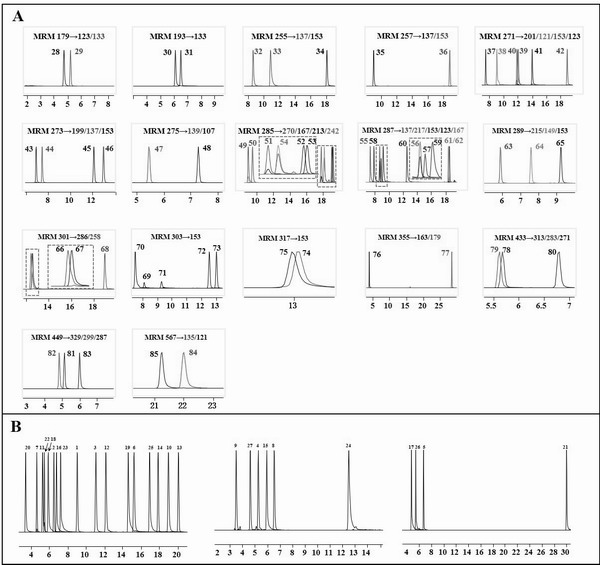Liquid chromatography-mass spectrometry analysis method of phenylpropane metabolic pathway metabolite and application thereof
A liquid chromatography-mass spectrometry and analysis method technology, applied in the field of biochemical metabolism analysis, can solve the problems of many isomers, low qualitative reliability, weak detection sensitivity, etc.
- Summary
- Abstract
- Description
- Claims
- Application Information
AI Technical Summary
Problems solved by technology
Method used
Image
Examples
Embodiment 1
[0027] Embodiment 1 Establishment of a liquid chromatography-mass spectrometry analysis method for phenylpropanoid metabolites:
[0028] 1. According to the synthesis sequence of the phenylpropanoid metabolic pathway, determine the metabolite category that needs to be analyzed and has a corresponding relationship: in order to determine the metabolite category that needs to be analyzed, the hydroxyl or methoxy group on the benzene ring is used as a replacement group during the synthesis process. The vertical classification standard, the horizontal classification standard is based on the compound types formed by the skeleton connection characteristics, and the structural periodic table of phenylpropanoid metabolites is established ( figure 2 ), a total of 103 metabolites were found for analysis.
[0029] 2. According to the structural characteristics of the metabolites, use the multiple reaction detection mode of the liquid mass analysis method to determine their analysis param...
Embodiment 2
[0031] Analysis of the content change trend of the phenylpropane metabolic pathway in the leaves of Ginkgo biloba in one year:
[0032] 1. Prepare samples for analysis
[0033] (1) Take 200 mg of Ginkgo biloba leaves to be tested in different months (stored at -80°C), and grind them fully under liquid nitrogen; (2) Add 1ml of 80% methanol and use ultrasonic-assisted extraction for 15 minutes at a temperature of 45°C; (3) Centrifuge at 12000g for 5 minutes, Take the supernatant extract; (4) add 1ml 80% methanol to the precipitate and repeat the above operation twice; (5) combine the three extracts, and use a nitrogen blower or a vacuum centrifuge to concentrate and volatilize the extract until there is no obvious Liquid; (6) add 80% methanol to dilute to 1ml, filter with 0.22μm organic membrane to remove impurities.
[0034] 2. Analyze the samples on the machine and obtain the analysis data
[0035] The samples were analyzed twice: 85 metabolites were analyzed in positive ion...
Embodiment 3
[0038] Example 3 Analysis of the change trend of phenylpropanoid metabolic pathways when soybean leaves are subjected to abiotic stress:
[0039] 1. Prepare samples for analysis
[0040] (1) Take 200 mg of soybean leaves to be tested (stored at -80°C) after salt treatment and drought treatment, and grind them fully under liquid nitrogen conditions; (2) Add 1ml of 80% methanol and use ultrasonic-assisted extraction for 15 minutes at a temperature of 45°C; (3 ) at 12000g for 5min, and take the supernatant extract; (4) add 1ml 80% methanol to the precipitate and repeat the above operation twice; Concentrate and evaporate until there is no obvious liquid; (6) add 80% methanol to make up to 1ml, and use a 0.22 μm organic filter membrane to remove impurities.
[0041] 2. Analyze the samples on the machine and obtain the analysis data
[0042] The samples were analyzed twice: 85 metabolites were analyzed in positive ion mode; 18 metabolites were analyzed in negative ion mode. (1) ...
PUM
 Login to View More
Login to View More Abstract
Description
Claims
Application Information
 Login to View More
Login to View More - R&D Engineer
- R&D Manager
- IP Professional
- Industry Leading Data Capabilities
- Powerful AI technology
- Patent DNA Extraction
Browse by: Latest US Patents, China's latest patents, Technical Efficacy Thesaurus, Application Domain, Technology Topic, Popular Technical Reports.
© 2024 PatSnap. All rights reserved.Legal|Privacy policy|Modern Slavery Act Transparency Statement|Sitemap|About US| Contact US: help@patsnap.com










